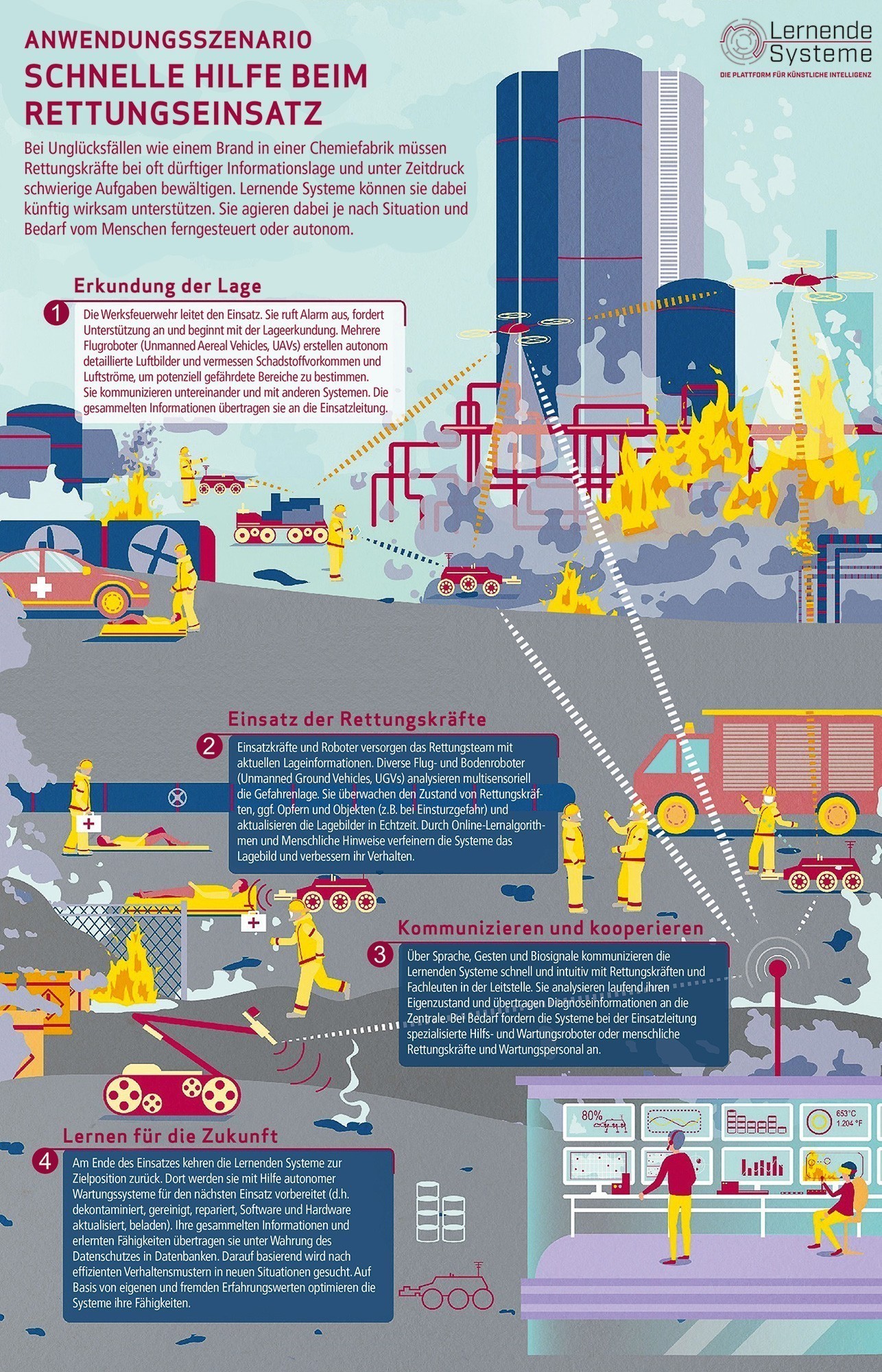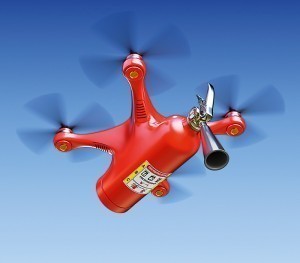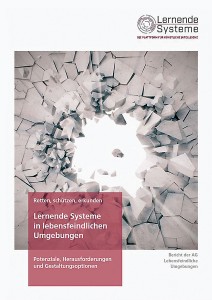Rescue operations, chemical accidents, exploring terrain that is difficult to access - the use of artificial intelligence in hostile environments promises beneficial solutions and the protection of human lives.
Potential and benefits
The use of learning systems in hostile environments therefore promises great benefits - together with humans, they can be used for various tasks, for example in the form of robots for the extraction of raw materials and food (e.g. aquaculture). In addition, AI-based systems offer great potential for research and industry, as their ability to learn means that they offer economic advantages over manned missions in dangerous and inaccessible environments or make missions possible in the first place. The Hostile Environments Working Group of the Learning Systems Platform initiated by the Federal Ministry of Education and Research (BMBF) has summarized the potential and requirements for the use of learning systems in hostile environments in its report, on which this article is based. To this end, fictitious application scenarios were designed that depict locations and possible activities. The various potentials that Learning Systems promise in hostile environments relate to many aspects, which are summarized and discussed here.
More safety for people
Learning systems can increase the safety of people in dangerous situations, because thanks to their capabilities, fewer people need to be on site in dangerous or catastrophic situations. On the one hand, learning systems can take over tasks that are dangerous or harmful to health and that were previously carried out by people - such as rescue work after a chemical accident. Even experts cannot always carry out these tasks efficiently because they lack information in dynamic hazardous situations or because time is short. On the other hand, AI systems support the emergency services by providing them with a quick overview of the situation. This means that rescue teams can be deployed more efficiently and with fewer resources. At the same time, such intelligent systems allow rescue and clean-up operations to be carried out more quickly, which may save more lives.
Sensible division of labor
Learning systems work independently, alone or in hybrid teams with other learning or autonomous systems and humans. As assistants, they assess dangers for humans, but are also capable of acting appropriately on their own in a specific situation. They can also request help - either for people or themselves. To do this, the systems collect information, exchange it with other systems and continue to learn. In this way, they gradually close existing knowledge gaps over time. Their use will fundamentally change the way we work and the division of labor in hostile environments. The learning system uses its physical properties (hardening), which are adapted to the environment, to remain in use for a long time under adverse conditions. People can use immersive technologies, for example, to contribute their experience and flexibility in the respective situation without having to be on site themselves.
Economicpotentialand sustainability
Learning systems also promise great potential benefits for infrastructures in hostile environments - for example in offshore wind turbines or on satellites in space. Up to now, their inspection has been associated with a high financial outlay for the operators and a risky physical effort on the part of the specialists. In some cases, it is simply impossible, for example on satellites. The maintenance of offshore wind farms is very cost-intensive and the work of divers and industrial climbers is sometimes associated with great danger to life. Learning systems are characterized here by their adaptability, learning ability and a design adapted to the specific place of use. In this way, learning robotic underwater systems can largely take over the appropriate inspection of offshore facilities in the future. Thanks to their ability to learn, they are able to react appropriately to subsystem failures (e.g. a camera or a drive unit) and at least partially compensate for them. Above-water parts of wind turbines or land-based wind turbines can be inspected by flying robots (often referred to as "drones"). This further reduces the logistical and personnel costs, which makes the use of learning systems better and more cost-effective.
As the example of offshore wind turbines illustrates, AI systems are also likely to make the operation of infrastructures more environmentally friendly and safer, as the manned systems used to date, such as helicopters, have a negative environmental impact and can be replaced in many areas by energy-efficient autonomous systems with a significantly better environmental footprint. Especially in such hostile environments, learning systems increase ecological and economic sustainability because they are permanently available and usable. In particular, the ability to learn makes it possible to keep such systems on site for long periods of time or permanently. This is the basis for the sustainable operation of systems and infrastructures - especially in hostile environments where humans cannot guarantee a permanent presence. Subsea resident AUVs (autonomous underwater vehicles), for example, would be able to monitor the condition of offshore wind power or oil and gas production facilities very precisely and permanently by monitoring them around the clock. Even the smallest disruptions to operations could be detected immediately and rectified quickly - or even prevented before they even occur by means of prediction. In order to illustrate the benefits and potential of learning systems more clearly, an application example will be examined in more detail:
Application example: Explosion and fire in a chemical plant
The increasing use of learning systems in disaster management and rescue operations will fundamentally change today's standard work processes. The application scenario schematically shows the possible course of such rescue operations with close cooperation between human rescue workers and various learning systems in hostile environments. The example also illustrates that AI systems not only minimize risks for emergency personnel and shorten response times in time-critical incidents, but that the knowledge gained can also be used and generalized to improve support for rescue workers with each operation.
Reconnaissance of the situation
So-called Unmanned Aerial Vehicles (UAV) autonomously create detailed aerial images of the large property and measure the occurrence of pollutants and air currents. The aim is to detect the possible spread of hazardous substances, narrow down the damage area and determine potentially endangered areas in the vicinity. The UAVs communicate and cooperate with each other and with other systems (e.g. ground robots, so-called Unmanned Ground Vehicles (UGV)) in order to explore critical areas quickly and in detail. They transmit the information to the incident command, which uses it as the basis for a comprehensive assessment of the situation.
Deployment of the rescue forces
The rescue teams work in teams with various robots. These ensure communication and logistics and provide all those involved with up-to-date situation information. Various UGVs and UAVs explore the route for other rescue teams, analyze the danger situation (e.g. the risk of collapse or leaks in buildings) and monitor the physical condition of rescue teams and victims. They can be integrated into first aid or rescue operations for transportation. People can use immersive technologies, for example, to contribute their experience and flexibility in the respective situation without having to be on site themselves.
Communicating and cooperating
Fast and intuitive interaction between humans and learning systems is necessary for effective rescue operations. Learning systems cooperate with humans in different ways - to apply greater force if a system cannot perform a task alone, to use special skills or tools (e.g. creating X-ray images or organizing the transport of injured persons), but above all to secure and support rescue workers. On the one hand, this requires adequate communication between humans and robots - via speech, gestures and biosignals such as gaze direction or skin resistance. On the other hand, robotic systems must communicate with the experts in a control center. To do this, learning systems constantly analyze their own condition and transmit diagnostic information to their control center. If necessary, they request specialized assistance and maintenance robots or human rescue workers and maintenance personnel from the control center.
Learning for the future
The information collected by the autonomous systems and the skills they have learned are transferred to corresponding databases for further use while ensuring data protection. Efficient patterns of behavior are sought in new situations - especially if interaction between man and machine was necessary. The capabilities of the systems are continuously optimized through learning procedures in a process that is controlled by humans, based on their own and other people's experience. In this way, support for the emergency services improves with every deployment.
Requirements and challenges
The systems are limited by the fact that very few of them have the cognitive abilities to meet the challenges, complexity and unpredictability of hostile environments on their own. In the future, however, technical systems should also be able to "understand" the complexity of hostile environments and process tasks efficiently. Learning systems that adapt to changing situations without having to be programmed to do so will be able to support people even better in dangerous situations. In order for learning systems to be used reliably, safely and for the benefit of humans in hostile environments and to exploit their economic potential, a number of challenges still need to be overcome. These primarily include technical challenges, such as ensuring long-term autonomy and autonomous learning in unknown environments on the basis of limited data. The design of the interaction and cooperation of autonomous robots or assistance systems with humans and protection against misuse must also be solved technically.
There are also non-technical challenges, primarily of a legal and ethical nature. Questions of responsibility, liability and insurance arise if the systems cause damage. Privacy and data protection issues can arise when learning systems collect and pass on data. The most important challenges are briefly explained here:
Technical challenges
- High degree of resilience:
Learning systems require a high degree of adaptivity. At the same time, they must be capable of fulfilling their task even if knowledge is incomplete and the functionality of individual subsystems is impaired. This requires them to be able to reconfigure themselves to a certain extent during use, for example to compensate for inadequate or failed sensors or actuators. The ability to learn is essential here. A modular design of a learning system can make compensation and adaptation much easier.
- Autonomous decision-making and learning:
Conditions and events in hostile environments are inherently unpredictable. Learning systems therefore have to perceive their environment using sensors, classify this perception and interpret it. On this basis, they should make independent decisions and plan and execute actions. The systems must learn from observation and experience, incorporating their previous knowledge (informed learning) and thus constantly expanding and improving their knowledge and skills.
- Learning from sparse data:
Some events that are relevant to the behavior of learning systems occur only very rarely. The learning methods used must therefore be able to learn from incomplete data and from a small number of examples or even from a single "formative" example or event (one-shot learning), for example by making greater use of prior knowledge or incremental learning methods.
- Mechanisms for transfer:
In order to use prior knowledge and experience as well as to exchange with other learning systems, mechanisms for the transfer of what has been learned as well as generalized learning (inductive learning) are required. Especially for hostile environments, it is important to formalize human prior knowledge and make it usable for learning systems.
- Extension by explanatory models:
Learning systems that make decisions must be able to record (log) them, represent them in a way that can be interpreted and, ideally, explain them. This is the only way to reconstruct the processes of an operation and learn lessons from any wrong decisions. At the very least, however, the decisions must be comprehensible, meaning that purely data-driven learning must be expanded to include decision, interpretation and explanation models.
- Protection against misuse:
Learning systems must be protected against misuse. In addition to general framework conditions in use (e.g. who may use a system when and where?), technical mechanisms are needed to prevent such systems from being used or misused outside their intended contexts and locations. This also applies to the learning of undesirable behavioral patterns based on data that has been supplied with manipulative intent. Apart from misuse, it must be ensured that the system does not learn undesirable behavioral patterns from "naturally occurring" data.
Legal and ethical challenges
- Liability issues:
As learning systems interact with people in different ways, questions arise regarding responsibility, liability and insurance, for example if damage is caused by the systems. In international areas of application, the regulation of property rights must also be clarified; for example, under current international maritime law, unmanned systems in international waters belong to the finder.
- Data protection:
The processing of personal information can lead to privacy and data protection problems. Such cases can occur when learning systems are used in disaster control or firefighting operations and collect and pass on data on the people affected. Independent decision-making systems can also find themselves in dilemma situations during rescue operations. One example of this is the so-called trolley dilemma: only one person can be cared for, even though several people need help. A formal framework must be found for dealing with such situations that takes technical, legal and ethical considerations into account.
 The application scenario of the Learning Systems Platform illustrates the future workflow for the use of learning systems in rescue operations (© Plattform Lernende Systeme)
The application scenario of the Learning Systems Platform illustrates the future workflow for the use of learning systems in rescue operations (© Plattform Lernende Systeme)
Outlook: Design options and framework conditions
Whether exploring terrain that is difficult to access, during rescue operations or in disaster control - learning systems can effectively support and protect people working in hazardous environments in many ways. However, it is indisputable that humans will continue to be irreplaceable as emergency personnel and decision-makers, especially when it comes to saving human lives. In order for learning systems to be used even more in hostile environments in the future, it is important to create a number of prerequisites and framework conditions. In Germany, learning systems for use in hostile environments are still a niche market. However, their potential to relieve humans of dangerous tasks in areas such as disaster control, aerospace, the maritime world or wind turbines is high. In order to exploit these opportunities, research and development activities in the field of robotics and AI for systems in hostile environments must be intensified and accelerated. To this end, it is necessary to solve important technical and scientific research questions, such as how to compensate for functional and subsystem failures through learning systems and how to enable systems and process personal data. In addition, simulation and (immersive) test environments should be established in which autonomous robots and rescue teams cooperate.
In addition to government funding, the potential and limitations of the applications must also be communicated and discussed publicly in order to strengthen the perception of social relevance and create trust in the systems. The practicability of systems is also measured by whether they are accepted by users. It is also important to create infrastructures, data pools and reference platforms for the research and development of learning systems in hostile environments, which can be operated by research institutions but used by all the various stakeholders involved. The promotion of innovation, for example through the development of business models and the creation of a uniform legal framework - such as common standards and independent certification in industry and research - are among other design options. The high economic potential of learning systems for use in hostile environments could thus also be exploited on international markets in the future.
Learning Systems Platform
The Learning Systems Platform was initiated by the Federal Ministry of Education and Research (BMBF) in 2017, bringing together expertise from science, business, politics and society, and supporting Germany's further development into a leading international technology provider for learning systems. The approximately 200 members of the platform are organized in working groups and a steering committee. They highlight the personal, social and economic benefits of learning systems and identify challenges and design options.
Link to the publication:
This article is based on the report of the Learning Systems Platform's working group on Hostile Environments. The report shows the opportunities and risks of using artificial intelligence in hazardous environments and identifies design options to make robotic support for emergency services a reality.
Platform Learning Systems (ed.):
Learning Systems in Hostile Environments - Report of the Hostile Environments Working Group, Munich 2019.
Available online at:
https://www.plattform-lernende-systeme.de/files/Downloads/Publikationen/AG-7_Bericht_web_final.pdf




